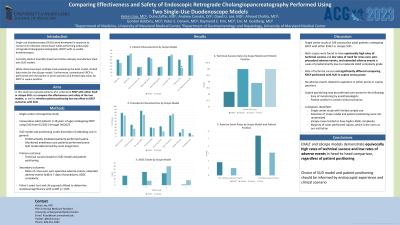Monday Poster Session
Category: Interventional Endoscopy
P2299 - Comparing Effectiveness and Safety of Endoscopic Retrograde Cholangiopancreatography Performed Using Two Single-Use Duodenoscope Models
Monday, October 23, 2023
10:30 AM - 4:15 PM PT
Location: Exhibit Hall

Has Audio

Kelvin Liao, MD
University of Maryland School of Medicine
Baltimore, MD
Presenting Author(s)
Kelvin Liao, MD1, Duha Zaffar, MD2, Andrew Canakis, DO3, David Lee, MD3, Ahmed Chatila, MD3, Gordon Robbins, MD3, Peter Darwin, MD3, Raymond Kim, MD, DM3, Eric Goldberg, MD3
1University of Maryland School of Medicine, Baltimore, MD; 2University of Maryland Medical Center Midtown Campus, Baltimore, MD; 3University of Maryland Medical Center, Baltimore, MD
Introduction: Single-use duodenoscopes (SUDs) were developed in response to concerns for infection transmission while performing endoscopic retrograde cholangiopancreatography (ERCP) with re-usable duodenoscopes. Currently, Boston Scientific (Exalt) and Ambu (aScope) manufacture their own SUD models. While there have been multiple trials evaluating the Exalt model, limited data exists for the aScope model. Furthermore, conventional ERCP is performed with the patient in prone position and limited data exists for ERCP in supine position. In this study we evaluate patients who underwent ERCP with either Exalt or aScope SUD and compare the effectiveness and safety of the two models, as well as whether patient positioning has any effect on ERCP outcomes with SUD.
Methods: Single-center retrospective study of consecutive adult patients undergoing ERCP with Exalt or aScope SUD between 1/2021-4/2023. Primary outcome was technical success and adverse events based on scope model as well as patient positioning. Secondary outcomes included the ASGE grade and procedural indication. Fisher’s exact test and chi-squared analysis were used to determine statistical significance between variables.
Results: 109 procedures were included (56 Exalt, 53 aScope). 81 cases were done in the supine position. The majority of cases were ASGE grade 2 (n=28) or grade 3 (n=45). Procedural indications and characteristics are listed in Table 1. Rates of technical success were 98.2% for Exalt and 100% for aScope with no statistically significant difference (Fisher’s test, p=1.0). Rates of peri-operative adverse events were 1.8% for Exalt (1 intrahepatic duct leak) and 0% for Ascope with no statistically significant difference (Fisher’s test, p=1.0). Rates of extended adverse events (within 10 days from procedure) were 5.4% for Exalt (1 sphincterotomy bleed, 1 pneumoperitoneum, 1 cholecystitis) and 0% for aScope with no statistically significant difference (Fisher’s test, p=0.24). Comparing ERCP’s performed in prone versus supine patient position, rates of technical success and adverse events were not statistically different.
Discussion: Our study highlights the efficacy of both SUD models. Regardless of patient positioning, there were high rates of technical success and low rates of adverse events, with no significant differences between models. Further studies are needed to determine whether our data is generalizable to ERCP performed outside of a tertiary center and to determine which clinical scenarios SUD should be utilized.
Disclosures:
Kelvin Liao, MD1, Duha Zaffar, MD2, Andrew Canakis, DO3, David Lee, MD3, Ahmed Chatila, MD3, Gordon Robbins, MD3, Peter Darwin, MD3, Raymond Kim, MD, DM3, Eric Goldberg, MD3. P2299 - Comparing Effectiveness and Safety of Endoscopic Retrograde Cholangiopancreatography Performed Using Two Single-Use Duodenoscope Models, ACG 2023 Annual Scientific Meeting Abstracts. Vancouver, BC, Canada: American College of Gastroenterology.
1University of Maryland School of Medicine, Baltimore, MD; 2University of Maryland Medical Center Midtown Campus, Baltimore, MD; 3University of Maryland Medical Center, Baltimore, MD
Introduction: Single-use duodenoscopes (SUDs) were developed in response to concerns for infection transmission while performing endoscopic retrograde cholangiopancreatography (ERCP) with re-usable duodenoscopes. Currently, Boston Scientific (Exalt) and Ambu (aScope) manufacture their own SUD models. While there have been multiple trials evaluating the Exalt model, limited data exists for the aScope model. Furthermore, conventional ERCP is performed with the patient in prone position and limited data exists for ERCP in supine position. In this study we evaluate patients who underwent ERCP with either Exalt or aScope SUD and compare the effectiveness and safety of the two models, as well as whether patient positioning has any effect on ERCP outcomes with SUD.
Methods: Single-center retrospective study of consecutive adult patients undergoing ERCP with Exalt or aScope SUD between 1/2021-4/2023. Primary outcome was technical success and adverse events based on scope model as well as patient positioning. Secondary outcomes included the ASGE grade and procedural indication. Fisher’s exact test and chi-squared analysis were used to determine statistical significance between variables.
Results: 109 procedures were included (56 Exalt, 53 aScope). 81 cases were done in the supine position. The majority of cases were ASGE grade 2 (n=28) or grade 3 (n=45). Procedural indications and characteristics are listed in Table 1. Rates of technical success were 98.2% for Exalt and 100% for aScope with no statistically significant difference (Fisher’s test, p=1.0). Rates of peri-operative adverse events were 1.8% for Exalt (1 intrahepatic duct leak) and 0% for Ascope with no statistically significant difference (Fisher’s test, p=1.0). Rates of extended adverse events (within 10 days from procedure) were 5.4% for Exalt (1 sphincterotomy bleed, 1 pneumoperitoneum, 1 cholecystitis) and 0% for aScope with no statistically significant difference (Fisher’s test, p=0.24). Comparing ERCP’s performed in prone versus supine patient position, rates of technical success and adverse events were not statistically different.
Discussion: Our study highlights the efficacy of both SUD models. Regardless of patient positioning, there were high rates of technical success and low rates of adverse events, with no significant differences between models. Further studies are needed to determine whether our data is generalizable to ERCP performed outside of a tertiary center and to determine which clinical scenarios SUD should be utilized.
Disclosures:
Kelvin Liao indicated no relevant financial relationships.
Duha Zaffar indicated no relevant financial relationships.
Andrew Canakis indicated no relevant financial relationships.
David Lee indicated no relevant financial relationships.
Ahmed Chatila indicated no relevant financial relationships.
Gordon Robbins indicated no relevant financial relationships.
Peter Darwin indicated no relevant financial relationships.
Raymond Kim: Apollo Endosurgery – Consultant. Cook medical – Consultant.
Eric Goldberg: Ambu – Consultant.
Kelvin Liao, MD1, Duha Zaffar, MD2, Andrew Canakis, DO3, David Lee, MD3, Ahmed Chatila, MD3, Gordon Robbins, MD3, Peter Darwin, MD3, Raymond Kim, MD, DM3, Eric Goldberg, MD3. P2299 - Comparing Effectiveness and Safety of Endoscopic Retrograde Cholangiopancreatography Performed Using Two Single-Use Duodenoscope Models, ACG 2023 Annual Scientific Meeting Abstracts. Vancouver, BC, Canada: American College of Gastroenterology.
